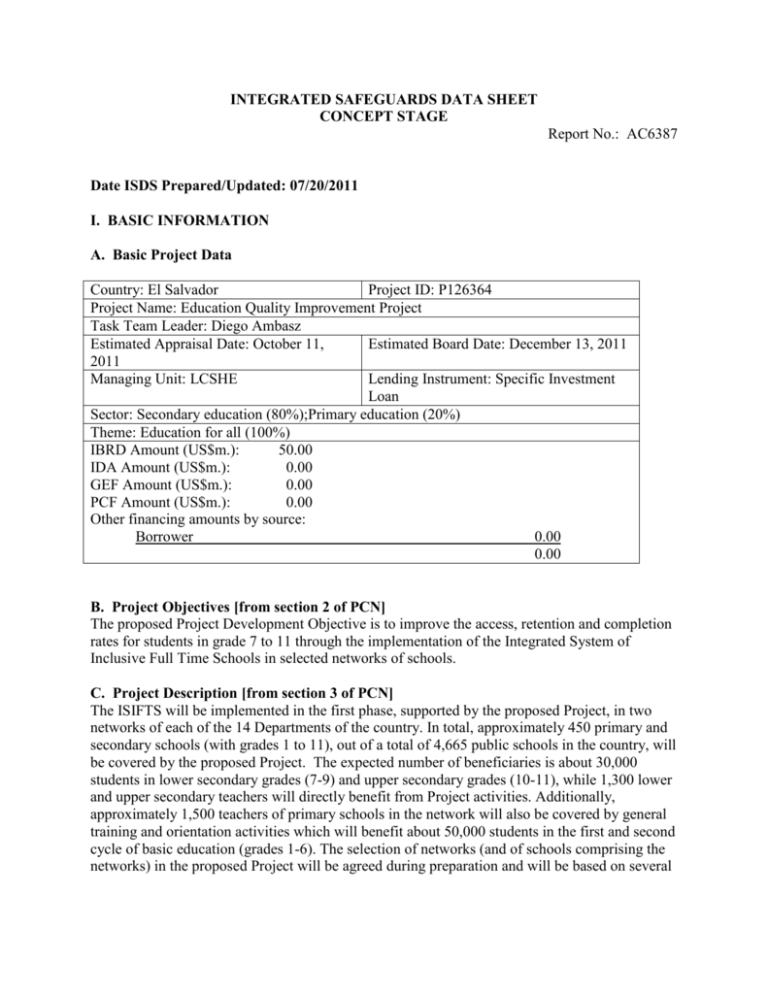Integrated Safeguards Data Sheet
advertisement

INTEGRATED SAFEGUARDS DATA SHEET CONCEPT STAGE Report No.: AC6387 Date ISDS Prepared/Updated: 07/20/2011 I. BASIC INFORMATION A. Basic Project Data Country: El Salvador Project ID: P126364 Project Name: Education Quality Improvement Project Task Team Leader: Diego Ambasz Estimated Appraisal Date: October 11, Estimated Board Date: December 13, 2011 2011 Managing Unit: LCSHE Lending Instrument: Specific Investment Loan Sector: Secondary education (80%);Primary education (20%) Theme: Education for all (100%) IBRD Amount (US$m.): 50.00 IDA Amount (US$m.): 0.00 GEF Amount (US$m.): 0.00 PCF Amount (US$m.): 0.00 Other financing amounts by source: Borrower 0.00 0.00 B. Project Objectives [from section 2 of PCN] The proposed Project Development Objective is to improve the access, retention and completion rates for students in grade 7 to 11 through the implementation of the Integrated System of Inclusive Full Time Schools in selected networks of schools. C. Project Description [from section 3 of PCN] The ISIFTS will be implemented in the first phase, supported by the proposed Project, in two networks of each of the 14 Departments of the country. In total, approximately 450 primary and secondary schools (with grades 1 to 11), out of a total of 4,665 public schools in the country, will be covered by the proposed Project. The expected number of beneficiaries is about 30,000 students in lower secondary grades (7-9) and upper secondary grades (10-11), while 1,300 lower and upper secondary teachers will directly benefit from Project activities. Additionally, approximately 1,500 teachers of primary schools in the network will also be covered by general training and orientation activities which will benefit about 50,000 students in the first and second cycle of basic education (grades 1-6). The selection of networks (and of schools comprising the networks) in the proposed Project will be agreed during preparation and will be based on several indicators, such as socio-economic status of the students, education indicators, and availability of infrastructure and teachers. The ISIFTS envisages changes to the governance structure of the education system to support the pedagogical changes at the school level. The changes in the governance structure include creation of the Direccion Central in each school network and establishing a management model integrating the MINED, the Direcciones Centrales and the schools, which is focused on clear objectives of improving student retention and learning, the continuous evaluation and monitoring of the processes and results, and targeting financial and technical support to schools, students and teachers to implement pedagogical reform. The proposed five year Project would finance activities in two components: (i) Strengthening Governance and Institutional Capacity of the Education System; and (ii) the Inclusive Full-Time School Model. These components are described below: Component 1: Strengthening Governance and Institutional Capacity of the Education System This component aims to enhance the efficiency, effectiveness, and management of the implementation of the Inclusive Full Time School Model by improving the governance of the education system and strengthening capacity in the Ministry of the Education. There would be five subcomponents: Subcomponent 1.1: Elaboration and Implementation of the Governance Structure for the ISIFTS. New roles, responsibilities and functions are envisaged for the MINED, Direccion Central of each network, and the school, focusing on student outcomes and the rationalization in the use of resources. This sub-component will finance technical assistance to define the organizational framework for each network, including the types of functions that will be carried out at the school, network and MINED levels; define the activities and capacities of the Direccion Central of each network; create the framework for information collection, supervision and pedagogical and technical assistance; define the standards of operation, teaching and student learning that will be implemented in the schools; and operationalize community involvement in the schools. The sub-component will also finance furniture and equipment for critical organizational units of the MINED (Direccion Nacional de Educacion, Direccion Nacional de Gestion Departamental, Direccion de Planificacion Educativa), and the 28 Direcciones Centrales and the design and implementation of a communication strategy for all stakeholders, and especially to involve the community in the school. Subcomponent 1.2: Strengthening Capacity of MINED to Operationalize the IFTS pedagogical model. Each school in the Project is expected to adapt the curriculum to the needs of a diverse group of students. Teachers will be organized in pedagogical teams in the schools to develop materials and teaching strategies. To this end, teacher competencies and jobs need to be re-defined. This sub-component would finance: (i) the definition of teacher competencies, performance standards and monitoring, and recruitment policy; (ii) the training of trainers to provide in-service training and support at the school level; (iii) the design and development of training modules on the pedagogical approach of the IFTS; (iv) the design of materials for carrying out training of MINED officials, the school network officials, teachers, directors and parents, and (v) the design of tools for evaluation of student learning. Subcomponent 1.3: Strengthening Capacity of MINED in Planning and Monitoring for Results. This sub-component will finance technical assistance to develop planning, budgeting and monitoring tools focusing on (a) the organization of school education services for the community, including criteria for deployment of teachers and the rational use of infrastructure, based on changes in demand (b) the strengthening of the information system and its use in planning and (c) organization of student assessment in the Inclusive Full Time Schools. Subcomponent 1.4: Impact Evaluation of the Project. This subcomponent would support the design and implementation of an impact evaluation to assess the impact of the Project. The design would be developed and agreed with the Government during project preparation. Subcomponent 1.5: Project Management. This subcomponent would strengthen the MINED at the central and network levels for the technical management, coordination and supervision of the proposed Project. This subcomponent would finance the following activities: (i) at the central level, a project coordinator and technical personnel (including fiduciary staff for procurement and financial staff); (ii) coordinators in the 14 Departments until such time as the Direcciones Centrales of the networks are established; (iii) the development and implementation of the monitoring system for the Project; (iv) financial audits of the Project; and (v) administrative costs. Component 2: The Inclusive Full Time School Model (IFTS) The Inclusive Full Time Inclusive School Model combines three major types of changes at the school level: an extensive pedagogical reform including incorporation of extra-curricular activities as part of schooling; re-organizing the management of schools to focus on student outcomes; and transformation of the relationship between the school actors (principals, teachers and local education authorities) and the local community. These changes are essential to making schooling relevant, useful and interesting to adolescents and hence contributing to retaining them in school. Within each of the 28 networks, the school day for grades 7 to 11 will be lengthened to 40 hours, from the current 25 hours, in order to provide better conditions for teaching and learning. Each school will provide one extra class period by day and will be utilized only by one shift of students. Grades 1-6 will benefit from teacher training and student evaluation/follow-up. This component will support the creation of the conditions for implementing the IFTS model in the selected schools through the training and support of teachers and principals; additional teaching-learning materials, information technology in the classroom and other basic equipment; and the improvement/re-organization of infrastructural facilities, including the availability of specialized classrooms, sports and recreational facilities. Other recurrent expenditures involved in the implementation of the Model include the extension of school hours and school feeding and transportation of students to the larger schools. During preparation, the extent of government financing for these expenditures will be assessed and the proposed Project may consider financing them on a declining basis. The following sub-components are envisaged: Subcomponent 2.1: Training and Professional Development of actors in the new model. This sub-component will support the orientation workshops of school directors, teachers, students and families and communities leaders on the new model; workshops for curriculum planning for each grade and subject by teachers; professional development days for teachers of each "nucleus;" training of teachers in student-centered pedagogy and new methods of student evaluation in the classroom; training of school directors on their new roles and responsibilities; workshops for planning at the school level and the design of early warning systems for detecting at risk students. Subcomponent 2.2: Materials, furniture and equipment for improved teaching-learning and extracurricular activities. The sub-component will finance additional books to cater to the diversity of learners; classroom and school libraries; furniture, materials and equipment for laboratories; furniture and equipment, including computers, for classrooms to facilitate collaborative and student- centered learning; materials and equipment for painting, music and physical education; additional resources for students with special needs. Subcomponent 2.3: Improvement of school infrastructural facilities. The Inclusive Full-Time School Model will necessitate the rehabilitation and renovation of existing school facilities to provide the right conditions for student-centered pedagogy and for extra-curricular activities as well as to accommodate more students due to the expansion of access. The sub-component will finance rehabilitation/ repair/ re-design of classrooms, teachers' rooms, water and sanitary facilities, art and sports facilities, and transfers to schools for building maintenance. Key risks and Issues Political risks: The Government will face elections in March 2012 and a sudden change in political forces may potentially weaken MINED's strong political will to implement the IFTS model using the IS strategy. Similarly, teachers that will benefit from the possibility of increasing their teaching load (and pay) within the scope of the new scheme may support the new model, but those whose teaching load will not be affected or those teachers who will not participate in the pilots may resent or resist the change, all of which may find echo in the teacher unions. If any of this materialized, the original political support for the Project may start fading as resistance become stronger. Capacity risks: There is a risk that the capacity of MINED to implement this Project may not be up to par, especially in regards to procurement and financial management procedures. Procurement for this Project is expected to be carried out by the Ministry's Procurement Unit (UACI). This is a new approach compared to previous Bank-financed projects, for which procurement was performed within a Project Implementation Unit (PIU). UACI has no previous experience applying Bank guidelines or procedures. Similarly, financial management (FM) is expected to be undertaken by MINED's Financial Unit, UFI, so a risk may arise due to low institutional capacity and lack of Bank project experience in this unit, as well. Social Assessment: A social assessment will be carried out by the Borrower. It includes a desk review, and free, prior and informed consultations with stakeholders and beneficiaries to ensure broad support to the Project. Department Directorates, local authorities, indigenous authorities, school directors, parents associations, students and civil society organizations will be consulted. The Social Assessment will inform the Project design and the Indigenous Peoples Planning Framework (IPPF). An important objective of the assessment will be to assess the potential measures to ensure the Project promotes access of indigenous school-age children/youths to schools, and that the benefits offered by the network scheme are culturally-adequate. The results of the social assessment will be discussed in a workshop with the Salvadoran authorities of the Ministries of Education and Culture, Indigenous organizations, the international cooperation, etc. D. Project location (if known) Nationwide E. Borrower’s Institutional Capacity for Safeguard Policies [from PCN] The Project will be implemented by the Ministry of Education (MINED) under the coordination and leadership of the Vice Ministry of Education/National Directorate of Education who will be responsible for overall Project coordination and monitoring. At this stage, the Project contemplates the creation of a Project Implementation Unit to support implementation of each Project component and monitor achievement of intended results. Its structure will be discussed with MINED authorities during the identification mission. The Ministry of Education, through the National Directorate of Education, will be responsible for Monitoring and Evaluation (M&E) of the Project. In principle, Project outcomes and results will be tracked and analyzed using MINED's institutional statistics and monitoring systems. Further support in terms of M&E will be discussed with MINED authorities. The Directorate of Integrated Community Management (Jefatura de Gestion Integral Ciudadana) is the Project counterpart for the formulation and implementation of the IPPF. This Directorate has experience conducting a program in support of schools attended by indigenous students in the Izalco and Nahuizalco Departments of El Salvador, with financing by UNESCO and UNICEF. Thus, MINED has the institutional capacity to formulate and implement the IPPF. The Bank team will include a social development specialist for follow-up and supervision. F. Environmental and Social Safeguards Specialists Ms Ximena B. Traa-Valarezo (LCSHE) Mr Gunars H. Platais (LCSEN) II. SAFEGUARD POLICIES THAT MIGHT APPLY Safeguard Policies Triggered Yes No TBD Environmental Assessment (OP/BP 4.01) X The interventions will imply a minimal degree of construction activities, thereby triggering OP/BP 4.01 (Environment). Mitigating steps will need to be defined during preparation, yet the bulk of activities involving any degree of construction will be mostly refurbishing and rehabilitating activities. As the exact school locations are unknown during preparation, an Environmental Management Framework will be developed and disclosed prior to Appraisal. The EMF will contain topics including but not limited to: the environmental mitigation and monitoring measures to be taken during implementation; sub-project eligibility criteria; waste disposal measures; construction site management criteria, including proper safety protocols for construction workers, and the use of personal protective equipment; dust and noise control; and Safeguard Policies Triggered Yes No TBD institutional arrangement for supervision and oversight of environmental measures. Natural Habitats (OP/BP 4.04) X The Project will include only minor construction that is not expected to cause degradation of natural habitats. Forests (OP/BP 4.36) X The Project will not be situated near forests and will not have any impact on forests. Pest Management (OP 4.09) X This Project will not include any procurement of pesticides and will not affect pest management in any way. Physical Cultural Resources (OP/BP 4.11) X Given that construction activity will be minimal, no significant physical cultural resources issues have been identified. The EMF will contain screening criteria to avoid areas of high cultural significance and procedures for handling chance finds during construction. Indigenous Peoples (OP/BP 4.10) X With regard to social safeguards, since 2006 the Directorate of Community Management (Jefatura de Gestion Integral Ciudadana) of MINED has acquired experience with implementation of the Integrated Community Development program (INCIDE) which has promoted Intercultural and Bilingual Education in indigenous schools in the Departments of Izalco and Nahuizalco, with financing by UNESCO and UNICEF. This Directorate will be the counterpart for the formulation and implementation of the Indigenous Peoples Planning Framework (IPPF). This is the first education project in El Salvador where OP/BP 4.10 is triggered. There is no legal recognition of Indigenous Peoples in the National Constitution; however, El Salvador ratified the UN Declaration of the Rights of Indigenous Peoples (September 2007). For the present project, OP/BP 4.10 (Indigenous Peoples) is triggered in those pilots where students from indigenous communities attend the schools included in the networks under the project. To better comply with the policy, the preparation mission proposed that a completely new network in the municipality with the greatest concentration of indigenous students (Izalco) be added to the universe of networks previously selected. Thus, the Indigenous Peoples Planning Framework (IPPF) may include not only the schools attended by indigenous students in the 28 networks of the Project, but also a new indigenous network, No. 29. The IPPF will be formulated by the Borrower in consultation with: (a) indigenous organizations presently working on MINED education programs, particularly CONCULTURA, CCNIS, and others; (b) school directors, parents and students. The indigenous population in El Salvador is estimated at approximately 2% of the total population. There are three salient groups: The Nahua/Pipil (Departments of Ahuachapan, Santa Ana, Sonsonate, La Libertad, San Salvador, La Paz and Chalatenango); the Poton Lenca (Departments of Usulutan, San Miguel, Morazan and La Union); and the Cacaopera (Departamento Morazan). Involuntary Resettlement (OP/BP 4.12) X The decision on triggering OP 4.12 Involuntary Resettlement will be deferred, pending consultation with the Team's social specialist together with the Client. Safeguard Policies Triggered Yes No TBD Safety of Dams (OP/BP 4.37) X The proposed Project will not involve the construction of dams and will not depend upon an existing dam or the construction of a dam. Projects on International Waterways (OP/BP 7.50) X The proposed Project will not affect international waterways. Projects in Disputed Areas (OP/BP 7.60) X The Project will not be situated in any disputed areas. Environmental Category: B - Partial Assessment III. SAFEGUARD PREPARATION PLAN A. Target date for the Quality Enhancement Review (QER), at which time the PAD-stage ISDS would be prepared: 09/07/2011 B. For projects that will not require a QER, the target date for preparing the PAD-stage ISDS: N/A C. Time frame for launching and completing the safeguard-related studies that may be needed. The specific studies and their timing1 should be specified in the PAD-stage ISDS. . IV. APPROVALS Signed and submitted by: Task Team Leader: Approved by: Regional Safeguards Coordinator: Comments: Sector Manager: Comments: 1 Mr Diego Ambasz 07/19/2011 Mr Glenn S. Morgan 07/19/2011 Ms Chingboon Lee 07/20/2011 Reminder: The Bank's Disclosure Policy requires that safeguard-related documents be disclosed before appraisal (i) at the InfoShop and (ii) in-country, at publicly accessible locations and in a form and language that are accessible to potentially affected persons.







